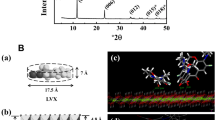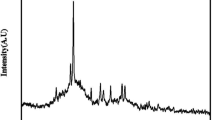Abstract
Many sites of bacterial infection such as in-dwelling catheters and orthopedic surgical sites require local rather than systemic antibiotic administration. However, currently used controlled release vehicles, such as polymeric films, release water-soluble antibiotics too quickly, whereas nonporous bone cement, used in orthopedics, release very little drug. The purpose of this study was to investigate the use of nanoparticulates composed of layered double hydroxide clays to bind various antibiotics and release them in a controlled manner. Mg–Al (carbonate) layered double hydroxides were synthesized and characterized using established methods. These clay particles were suspended in solutions of the antibiotics tetracycline, doxorubicin (DOX), 5-fluorouracil, vancomycin (VAN), sodium fusidate (SF) and antisense oligonucleotides and binding was determined following centrifugation and quantitation of the unbound fraction by UV/Vis absorbance or HPLC analysis. Drug release from layered double hydroxide clay/drug complexes dispersed in polymeric films was measured by incubation in phosphate-buffered saline (pH 7.4) at 37 °C using absorbance or HPLC analysis. Antimicrobial activity of drug released from film composites was determined using zonal inhibition studies against S. epidermidis. All drugs bound to the clay particles to various degrees. Generally, drugs released with a large burst phase of release (except DOX) with little further drug release after 4 days. Dispersion of drug/clay complexes in poly(lactic-co-glycolic acid) films resulted in a reduced burst phase of release and a slow continuous release for many weeks with effective antimicrobial amounts of VAN and SF released at later time points. Layered double hydroxide clays may be useful for controlled release applications at sites requiring long-term antibiotic exposure as they maintain the drug in a non-degraded state and release effective amounts of drug over long time periods. LDH clay/drug complexes are amenable to homogenous dispersion in polymeric films where implant coating may be optimal or required.





Similar content being viewed by others
References
Li F, Duan X. Layered double hydroxides. Structure and Bonding. Vol.119. In: Duan, Xue, Evans, David G (editors) Applications of layered double hydroxides. Berlin: Springer; 2006. XII.
Tarnawski A, Pai R, Itani R, Wyle FA. The antacid Talcid adsorbs and neutralizes all proteins secreted by H. pylori including VacA cytotoxin: a new mechanism for its ulcer-healing action? Digestion. 1999;60(5):449–55.
Aguzzi C, Cerezo P, Viseras C, Caramella C. Use of clays as drug delivery systems: possibilities and limitations. Appl Clay Sci. 2007;36(1–3):22–36. doi:10.1016/j.clay.2006.06.015.
Mohanambe L, Vasudevan S. Anionic clays containing anti-inflammatory drug molecules: comparison of molecular dynamics simulation and measurements. J Phys Chem B. 2005;109(32):15651–8. doi:10.1021/jp050480m.
Li B, He J, Evans DG, Duan X. Inorganic layered double hydroxides as a drug delivery system—intercalation and in vitro release of fenbufen. Appl Clay Sci. 2004;27(3–4):199–207. doi:10.1016/j.clay.2004.07.002.
Khan AI, O’Hare D. Intercalation chemistry of layered double hydroxides: recent developments and applications. J Mater Chem. 2002;12(11):3191–8. doi:10.1039/b204076j.
Ambrogi V, Fardella G, Grandolini G, Perioli L. Intercalation compounds of hydrotalcite—like anionic clays with antiinflammatory agents-I. Intercalation and in vitro release of ibuprofen. Int J Pharm. 2001;220(1–2):23–32.
Gordijo CuR, Barbosa CsAs, Da Costa Ferreira AM, Constantino VRL, Oliveira Silva Dd. Immobilization of ibuprofen and copper-ibuprofen drugs on layered double hydroxides. J Pharm Sci. 2005;94(5):1135–48. doi:10.1002/jps.20336.
Kong X, Jin L, Wei M, Duan X. Antioxidant drugs intercalated into layered double hydroxide: structure and in vitro release. Appl Clay Sci. 2010;49(3):324–9. doi:10.1016/j.clay.2010.06.017.
Viseras C, Cerezo P, Sanchez R, Salcedo I, Aguzzi C. Current challenges in clay minerals for drug delivery. Appl Clay Sci. 2010;48(3):291–5. doi:10.1016/j.clay.2010.01.007.
Trikeriotis M, Ghanotakis DF. Intercalation of hydrophilic and hydrophobic antibiotics in layered double hydroxides. Int J Pharm. 2007;332(1–2):176–84. doi:10.1016/j.ijpharm.2006.09.031.
Ryu S-J, Jung H, Oh J-M, Lee J-K, Choy J-H. Layered double hydroxide as novel antibacterial drug delivery system. J Phys Chem Solids. 2010;71(4):685–8. doi:10.1016/j.jpcs.2009.12.066.
Tammaro L, Costantino U, Bolognese A, Sammartino G, Marenzi G, Calignano A, et al. Nanohybrids for controlled antibiotic release in topical applications. Int J Antimicrob Agents. 2007;29(4):417–23. doi:10.1016/j.ijantimicag.2006.11.019.
Knetsch MLW, Koole LH. New strategies in the development of antimicrobial coatings: the example of increasing usage of silver and silver nanoparticles. Polymers. 2011;3(1):340–66. doi:10.3390/polym3010340.
Ramritu P, Halton K, Collignon P, Cook D, Fraenkel D, Battistutta D, et al. A systematic review comparing the relative effectiveness of antimicrobial-coated catheters in intensive care units. Am J Infect Control. 2008;36(2):104–17. doi:10.1016/j.ajic.2007.02.012.
Wu P, Grainger DW. Drug/device combinations for local drug therapies and infection prophylaxis. Biomaterials. 2006;27(11):2450–67. doi:10.1016/j.biomaterials.2005.11.031.
Jackson J, Leung F, Duncan C, Mugabe C, Burt H. The use of bone cement for the localized, controlled release of the antibiotics vancomycin, linezolid, or fusidic acid: effect of additives on drug release rates and mechanical strength. Drug Deliv Transl Res. 2011;1(2):121–31. doi:10.1007/s13346-011-0015-5.
Andollina A, Bertoni G, Zolezzi C, Trentani F, Trentani P, Maria Borrelli A, et al. Vancomycin and meropenem in acrylic cement: elution kinetics of in vitro bactericidal action. Chir Organi Mov. 2008;91(3):153–8. doi:10.1007/s12306-007-0025-0.
Chakraborti M, Jackson JK, Plackett D, Brunette DM, Burt HM. Drug intercalation in layered double hydroxide clay: application in the development of a nanocomposite film for guided tissue regeneration. Int J Pharm. 2011;416(1):305–13. doi:10.1016/j.ijpharm.2011.06.016.
Long KA, Jackson JK, Yang C, Chehroudi B, Brunette DM, Burt HM. Controlled release of alendronate from polymeric films. J Biomater Sci Polym Ed. 2009;20(5–6):653–72. doi:10.1163/156856209X426457.
Woodford N, Wareham DW. Tackling antibiotic resistance: a dose of common antisense? J Antimicrob Chemother. 2008;63(2):225–9. doi:10.1093/jac/dkn467.
Chopra I. Prospects for antisense agents in the therapy of bacterial infections. Expert Opin Investig Drugs. 1999;8(8):1203–8. doi:10.1517/13543784.8.8.1203.
Springate CM, Jackson JK, Gleave ME, Burt HM. Clusterin antisense complexed with chitosan for controlled intratumoral delivery. Int J Pharm. 2008;350(1–2):53–64. doi:10.1016/j.ijpharm.2007.08.018.
Ambrogi V, Fardella G, Grandolini G, Perioli L, Tiralti MC. Intercalation compounds of hydrotalcite—like anionic clays with anti-inflammatory agents, II: uptake of diclofenac for a controlled release formulation. AAPS Pharm Sci Tech. 2002;3(3):E26. doi:10.1208/pt030326.
Author information
Authors and Affiliations
Corresponding author
Rights and permissions
About this article
Cite this article
Chakraborti, M., Jackson, J.K., Plackett, D. et al. The application of layered double hydroxide clay (LDH)-poly(lactide-co-glycolic acid) (PLGA) film composites for the controlled release of antibiotics. J Mater Sci: Mater Med 23, 1705–1713 (2012). https://doi.org/10.1007/s10856-012-4638-y
Received:
Accepted:
Published:
Issue Date:
DOI: https://doi.org/10.1007/s10856-012-4638-y




